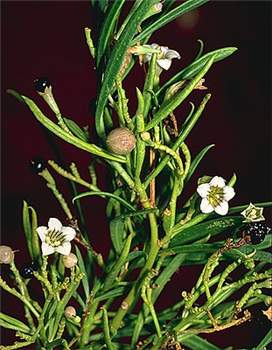Taxonomy
Duboisia R.Br., Prodr. 448 (1810); named in honour of Charles Dubois (1656–1740), a London merchant and patron of botany.
Type species: D. myoporoides R.Br.
Entrecasteauxia Montr., Mém. Acad. Roy. Sci. Lyon, Sect. Sci. ser. 2, 10: 244 (1860).
Type species:E. elliptica Montr.
[Anthocercis auct. non Labill.; F.Muell., Fragm. Phytogr. Austral. 2: 138 (1861), 6: 142 (1868).]
Large shrubs or small trees, glabrous or almost so. Leaves alternate, simple, sessile or shortly petiolate. Inflorescence panicle- or cyme-like, terminal, leafy. Flowers bisexual, actinomorphic or slightly zygomorphic, subtended by pairs of opposite bracts. Calyx campanulate, 5–lobed. Corolla campanulate, white with purple striations in throat; tube funnel-shaped to campanulate; limb 5–lobed, the lobes short and broad or long and narrow, induplicate in bud. Stamens 4, sometimes 5, didynamous, inserted at base of corolla-tube; a staminode sometimes present; anthers unilocular, not cohering, dehiscing by a terminal, semicircular slit. Ovary bilocular; stigma capitate, very shortly bilobed. Fruit a succulent berry. Seeds reniform. n=30; L.Haegi, Telopea 2: 173 (1981).
A genus of 4 species occurring on the Australian mainland; three species endemic and one also in New Caledonia. Species contain alkaloids of the nicotine and tropane groups.
T.H.Johnston & J.B.Cleland, The history of the Aboriginal narcotic, pituri, Oceania 4: 201–233, 268–289 (1933–1934); C.Barnard, The duboisias of Australia, Econ. Bot. 6: 3–17 (1952); L.Haegi, Australian genera of the Solanaceae, in J.G. Hawkes et al., Linn. Soc. Symp. Ser. 7: 121–124 (1979); N.Peterson, Aboriginal uses of Australian Solanaceae, in Hawkes et al., op. cit. 171–190.
Changes since the Flora of Australia treatment
1. A new species, D. arenitensis Craven, Lepschi & Haegi from western Arnhem Land was described in J. Adelaide Bot. Gard. 16: 27 (1995). The species is known only by the type.
According to the authors of this species there is no one characteristic which separates it from the other three known Duboisia species. However the single collection known occurs well outside the distributional range of the rest of the species. A table comparing all four species and a key to the species is provided in their publication.
2. Phylogenetic studies by Garcia & Olmstead (2003) on the Tribe Anthocercideae using two chloroplast DNA regions indicated that Cyphanthera and Duboisia are not monophyletic and these genera may need to be recircumscribed in the future. C. odgersii showed a closer relationship to Grammosolen while the rest of the Cyphanthera species combined to form a clade with Duboisia and Crenidium.
Reference: V.F.Garcia & R.G.Olmstead (2003). Phylogenetics of Tribe Anthocercideaea (Solanaceae) based on ndhF and trnL/F sequence data. Systematic Botany 28: 609-615.
3. A history of the use of Duboisia as a source of alkaloids in
Reference: Foley, P. (2006). Duboisia myoporoides: the medical career of a native Australian plant. Historical Records of Australian Science 17: 31-69.
Key to species
Revised key reproduced from Craven & Lepschi, A new Australian species of Duboisia R.Br. (Solanaceae). J. Adelaide Bot. Gard. 16: 27-31(1995).
1 Leaves with blade mostly narrowly elliptic to linear2 Leaves usually petiolate, rarely sessile; calyx lobes very narrowly triangular to sublinear; corolla lobes narrowly ovate to narrowlytriangular, 0.4 - 0.5 times as long as corolla; corolla 5-8 mm long
Duboisia arenitensis
2: Leaves usually sessile, rarely petiolate; calyx lobes triangular to broadly triangular; corolla lobes broadly ovate to orbicular, 0.1- 0.3 times as long as corolla; corolla 7-15.5 mm long
Duboisia hopwoodii
1: Leaves with blade mostly obovate to obovate-elliptic or ovate to narrowly ovate or ovate-elliptic
3 Leaves with blade mostly obovate to obovate-elliptic, apex acute to obtuse; corolla lobes broadly rounded
Duboisia myoporoides
3: Leaves with blade mostly ovate to narrowly ovate or ovate-elliptic, apex acuminate; corolla lobes narrowly acute
4 Pedicel 1.5-3.5 mm long; corolla 5-8 mm long, lobes 1.75-4 mm long
Duboisia arenitensis
4: Pedicel 10-16 mm long; corolla 13-19 mm long, lobes 6.5-11.5 mm long
Duboisia leichhardtii


